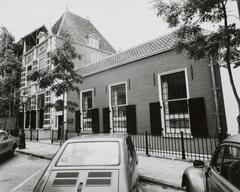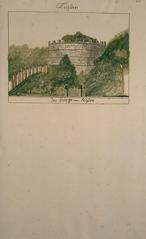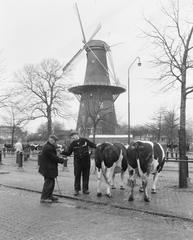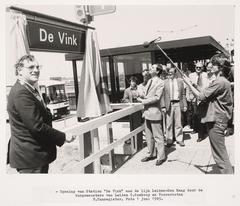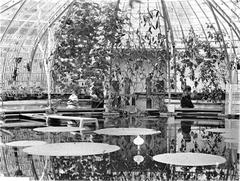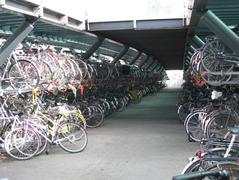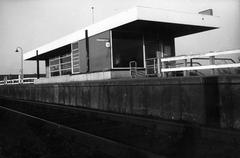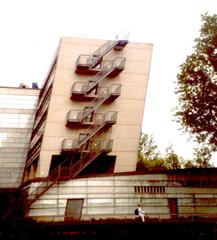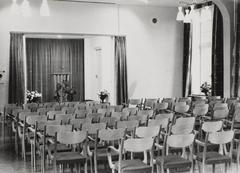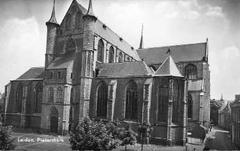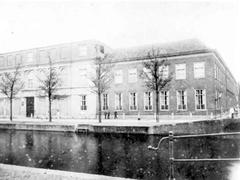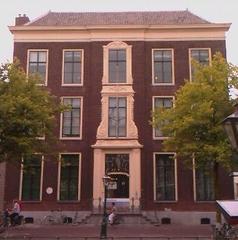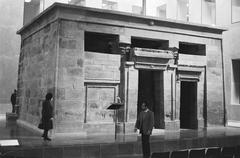Doelenbrug Leiden: Visiting Hours, Tickets, and Historical Sites Guide
Date: 04/07/2025
Introduction
Nestled in the heart of Leiden, the Doelenbrug is a historic masonry arch bridge that serves as both a functional crossing and a living monument to the city’s rich history and culture. Dating back to the late 14th century and reconstructed in stone during the 17th century, the Doelenbrug reflects Leiden’s Golden Age prosperity, architectural elegance, and civic heritage. It offers visitors panoramic views of the Rapenburg canal, connects them to nearby cultural landmarks, and stands as a symbol of the city’s resilience and vibrant urban life. This guide covers everything from the bridge’s origins to visiting hours, travel tips, accessibility, and nearby attractions (Leiden History 101; Leiden Tourist Map; Lonely Planet).
Table of Contents
- Introduction
- Origins and Early Development
- Architectural Evolution
- Role in Leiden’s Urban and Social Fabric
- Visiting the Doelenbrug: Hours, Accessibility & Tips
- Nearby Attractions and Guided Tours
- Restoration and Preservation
- Historical Context: Leiden in the 16th and 17th Centuries
- Travel and Accessibility Information (2024–2025)
- Frequently Asked Questions (FAQ)
- Conclusion and Call to Action
Origins and Early Development
The Doelenbrug’s story begins in the late 14th century, when a wooden bridge, known as the “quaeckelbruggetgen,” first spanned the Rapenburg canal. It was designed to facilitate boat passage and support city defenses, providing access for Leiden’s schutters (civic guards) from Doelensteeg to Houtstraat. This strategic link highlights the careful urban planning of medieval Leiden, integrating infrastructure with civic defense needs.
Architectural Evolution
In 1578, the original wooden bridge was replaced by a stone structure, symbolizing Leiden’s prosperity and technological advancement. Renewed in 1610, the bridge received wooden railings in 1637 and iron railings in 1668, reflecting evolving standards of safety and aesthetics. The current bridge showcases three sandstone arches with decorative carvings, characteristic of Dutch Golden Age design.
Role in Leiden’s Urban and Social Fabric
Located beside the prestigious Rapenburg canal and adjacent to the Rijksmuseum van Oudheden, the Doelenbrug has long been more than a crossing point. Historically, it facilitated movement for the city’s militia and connected key parts of Leiden’s civic and academic life. Over time, it has become an essential pedestrian pathway and a beloved symbol of Leiden’s cultural identity.
Visiting the Doelenbrug: Hours, Accessibility & Tips
- Visiting Hours: The Doelenbrug is a public bridge, accessible 24 hours a day, year-round. No tickets or entrance fees are required.
- Accessibility: The bridge is pedestrian- and wheelchair-friendly, with smooth surfaces and gentle slopes. Some surrounding streets feature historic cobblestones.
- Travel Tips: The best experiences are during early morning or late afternoon for optimal photography. The bridge is easy to include on a walking tour of Leiden’s historic center.
- Safety: The bridge is well-maintained for pedestrians; be cautious during wet weather as surfaces may be slippery.
Nearby Attractions and Guided Tours
Within a short walk from Doelenbrug, visitors can explore:
- Rijksmuseum van Oudheden: Dutch National Museum of Antiquities.
- Old Leiden Observatory: A testament to Leiden’s scientific heritage.
- Leiden University: Founded in 1575, one of the city’s cultural anchors.
- Burcht van Leiden: Medieval fortress with panoramic views (thecrazytourist.com).
- Pieterskerk: Monumental Gothic church.
Many guided walking and canal tours include Doelenbrug, offering historical insights and stories that enrich your visit (Nova on the Road; Visit Leiden).
Restoration and Preservation
Declared a Rijksmonument in 1968, the Doelenbrug benefits from legal protection and ongoing conservation. The most significant restoration took place in 1981, ensuring both safety and historical integrity. Its use as a canvas for contemporary art, such as the 1991 rope sculpture, attests to its continued relevance in Leiden’s cultural life.
Historical Context: Leiden in the 16th and 17th Centuries
Leiden was Holland’s largest city during the late 15th and early 16th centuries, thriving on a booming textile industry. The city’s resilience during the Eighty Years’ War, especially the 1574 siege, led to the founding of Leiden University. The Doelenbrug’s stone reconstruction in 1578 and subsequent enhancements mirror Leiden’s Golden Age, a period marked by scientific, artistic, and commercial achievements (Leiden History 101).
Travel and Accessibility Information (2024–2025)
Location and Access
Doelenbrug is located at Noordeinde/Rapenburg in Leiden’s city center, about a 10–15 minute walk from Leiden Centraal railway station. The area is renowned for its canal views and classic Dutch architecture.
Roadworks and Access Updates
From June 2024 to January 2025, Noordeinde is closed to motorized traffic and cyclists for infrastructure improvements. Pedestrian access to Doelenbrug remains open, with temporary reopening during major events like Leidens Ontzet (Leiden municipality website).
Getting There
- By Train: Arrive at Leiden Centraal, then walk to the city center.
- By Bus: City buses stop near Noordeinde or Rapenburg.
- By Bicycle: Cyclists must follow detours due to roadworks; secure parking is available near the center.
- By Car: Car access is limited; use city parking garages and continue on foot.
Facilities
- Cafés & Restaurants: Numerous options nearby, many with canal views.
- Public Toilets: Available in museums and public buildings.
- Accessibility: Wheelchair-friendly bridge, though cobblestones may present minor challenges.
Frequently Asked Questions (FAQ)
Q: Is there an entrance fee to visit Doelenbrug?
A: No, the bridge is free and open to the public at all times.
Q: What are the best hours to visit?
A: Anytime, but daylight hours in spring and summer offer the best atmosphere.
Q: Is Doelenbrug wheelchair accessible?
A: Yes, though some approaches have cobblestones.
Q: Are guided tours available?
A: Yes, many walking and canal tours include Doelenbrug.
Q: Can I cycle on the bridge?
A: Cycling is not permitted on the pedestrian-only bridge.
Q: Where can I get updates on construction and access?
A: Visit the Leiden municipality website for the latest information.
Conclusion and Call to Action
The Doelenbrug is much more than a historic bridge—it is a gateway into Leiden’s enduring legacy and vibrant present. From its origins as a link for the city’s militia to its role today as a scenic and cultural hub, the bridge invites visitors to discover stories beneath its arches and to connect with the city’s artistic, academic, and communal spirit. With year-round free access, guided tour options, and proximity to key attractions, Doelenbrug is a must-visit for anyone exploring Leiden. Plan your visit, download the Audiala app for guided tours and insider tips, and follow us for updates on Leiden’s heritage and events. Capture the beauty, history, and energy of this remarkable city—starting at the Doelenbrug (Leiden Continuum; Visit Leiden; Nova on the Road).
References
- Doelenbrug Leiden: History, Visiting Hours, and Tourist Guide, 2024 (Leiden History 101)
- Visiting Doelenbrug in Leiden: History, Tips, and Attractions, 2024 (Leiden Tourist Map)
- Explore Doelenbrug in Leiden: Visiting Hours, Tickets & Travel Tips for This Historic Bridge, 2024 (Leiden municipality website)
- Visiting the Doelenbrug in Leiden: Historical Significance, Visiting Hours, Tickets & Insider Tips, 2024 (Lonely Planet)
- Visiting the Doelenbrug in Leiden: Historical Significance, Visiting Hours, Tickets & Insider Tips, 2024 (Nova on the Road)
- Visiting the Doelenbrug in Leiden: Historical Significance, Visiting Hours, Tickets & Insider Tips, 2024 (Visit Leiden)
